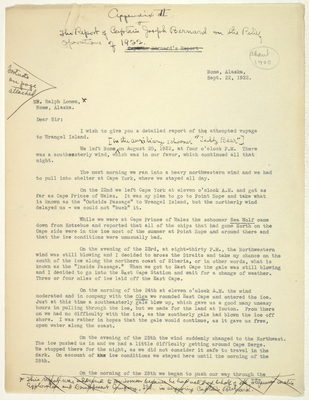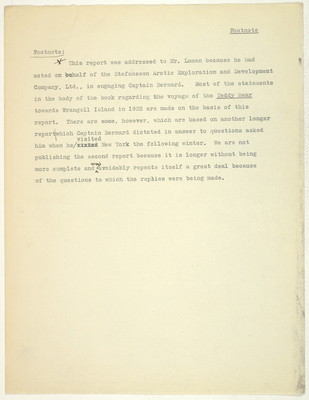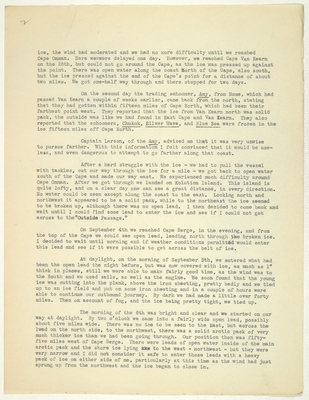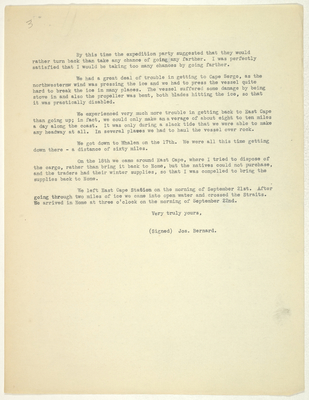Pages
stefansson-wrangel-09-30-001-001
Appendix II
The Report of Captian Joseph Bernard on the [Relief] Operations of 1922. Captain Bernard's Report
about 1400
Nome, Alaska, Sept. 22, 1922.
Footnote on page attached
MR. Ralph Lomen, * Nome, Alaska.
Dear sir:
I wish to give you a detailed report of th$ attempted voyage to Wrangel Island.
We left Nome [in the auxiliary schooner "Teddy Bear"] on August 20, 1922, at four o'clock P.M. There was a southeasterly wind, which was in our favor, which continued all that night.
The next morning we ran into a heavy northwestern wind and we had to pull into shelter at Cape York, where we stayed all day.
On the 22nd we left Cape York at eleven o'clock A.M. and got as far as Cape Prince of Wales. It was my plan to go to Point Hope and take what is known as the "Outside Passage" to Wrangel Island, but the northerly wind delayed us - we could not "buck" it.
While we were at Cape Prince of Wales the schooner Sea Wolfcame down from Kotzebue and reported that all of the ships that had gone North on the Cape side were in the ice most of the summer at Point Hope and around there and that the ice conditions were unusually bad.
On the evening of the 23rd, at eight-thirty P.M., the Northwestern wind was still blowing and I decided to cross the Straits and take my chance on the south of the ice along the northern coast of Siberia, or in other words, what is known as the "Inside Passage." When we got to East Cape the gale was still blowing and I decided to go into the East Cape Station and wait for a change of weather. Three or four miles of ice laid off the East Cape.
On the morning of the 24th at eleven o'clock A.M. the wind moderated and in company with the Olga we rounded East Cape and entered the ice. Just at this time a southeasterly gale blew up, which gave us a good many uneasy hours in pulling through the ice, but we made for the land at Youton. From there on we had no difficulty with the ice, as the southerly gale had blown the ice off shore. I was rather in hopes that the gale would continue, as it gave us free, open water along the coast.
On the evening of the 25th the wind suddenly changed to the Northwest. The ice pushed us in and we had a little difficulty getting around Cape Serge. We stopped there for the night, as we did not consider it safe to travel in the dark. On account of the ice conditions we stayed here until the morning of the 28th.
On the morning of the 28th we began to push through the
*This report was addressed to Mr. Lomen because he had asked on behalf of the Stefansson Arcitc Exploration and Development Company, LTD. in engaging Captain Bernard.
stefansson-wrangel-09-30-001-002
Footnote
Footnote:
*This report was addressed to Mr. Lomen because he had acted on behalf of the Stefansson Arctic Exploration and Development Company, Ltd., in engaging Captain Bernard. Most of the statements in the body of the book regarding the voyage of the Teddy Bear towards Wrangell Island in 1922 are made on the basis of this report. There are some, however, which are based on another longer report which Captain Bernard dictated in answer to questions asked him when he visited New York the following winter. We are not publishing the second report because it is longer without being more complete and unavoidably repeats itself a great deal because of the questions to which the replies were being made.
stefansson-wrangel-09-30-001-003
2
ice, the wind had moderated and we had no more difficulty until we reached Cape Onman. Here wewwere delayed one day. However, we reached Cape Van Kearn on the 28th, but could not go around the Cape, as the ice was pressed up against the point. There was open water along the coast North of the Cape, also south, but the ice pressed against the end of the Cape's point for a distance of about two miles. We got one-half way through and there stopped for two days.
On the second day the trading schooner, Amy, from Nome, which had passed Van Kearn a couple of weeks earlier, came back from the north, stating that they had gotten within fifteen miles of Cape North, which had been their farthest point west. They reported that the ice from Van Kearn north was solid pack, the outside was like we had found in East Cape and Van Kearn. They also reported that the schooners, Chukok, Silver Wave, and Blue Sea were frozen in the ice fifteen miles off Cape North.
Captain Larson, of the Amy, advised me that it was very unwise to pursue farther. With this information I felt convinced that it would be useless, and even dangerous to attempt to go farther along that coast.
After a hard struggle with the ice - we had to pull the vessel with tackles, cut our way through the ice for a mile - we got back to open water south of the Cape and made our way east. We experienced much difficulty around Cape Onman. After we got through we landed on Kolution Island. This island is quite lofty, and on a clear day one can see a great distance, in every direction. No water could be seen except along the coast to the east. Looking north and northwest it appeared to be a solid pack, while to the northeast the ice seemed to be broken up, although there was no open lead. I then decided to come back and wait until I could find some lead to enter the ice and see if I could not get across to the"Outside Passage."
On September 4th we reached Cape Serge, in the evening, and from the top of the Cape we could see open lead, leading north through the broken ice. I decided to wait until morning and if weather conditions permitted would enter this lead and see if it were possible to get across the belt of ice.
At daylight, on the morning of September 5th, we entered what had been the open lead the night before, but was now covered with ice, as much as 1" thick in places, still we were able to make fairly good time, as the wind was to the South and we used sails, as well as the engine. We soon found that the young ice was cutting into the plank, above the iron sheeting, pretty badly and we tied up to an ice field and put on some iron sheeting and in a couple of hours were able to continue our outbound journey. By dark we had made a little over forty miles. Then on account of fog, and the ice being pretty tight, we tied up.
The morning of the 6th was bright and clear and we started on our way at daylight. By two o'clock we came into a fairly wide open lead, possibly about five miles wide. There was no ice to be seen to the East, but across the lwad on the north side, to the northwest, there was a solid arctic pack of very much thicker ice than we had been going through. Our position then was fiftyfive miles west of Cape Serge. There were leads of open water inside of the main arctic pack and the shore ice lying the to the west - northwest - but they were very narrow and I did not consider it safe to enter those leads with a heavy pack of ice on either side of me, particularly at this time as the wind had just sprung up from the northwest and the ice began to close in.
stefansson-wrangel-09-30-001-004
By this time the expedition party suggested that they would rather turn back than take any chance of going any farther. I was perfectly satisfied that I would be taking too many chances by going farther.
We had a great deal of trouble in getting to Cape Serge, as the northwesternw wind was pressing the ice and we had to press the vessel quite hard to break the ice in many places. The vessel suffered some damage by being stove in and also the propeller was bent, both blades hitting the ice, so that it was practically disabled.
We experienced very much more trouble in getting back to East Cape than going up; in fact, we could only make an average of about eight to ten miles a day along the coast. It was only during a slack tide that we were able to make any headway at all. In several places we had to haul the vessel over rock.
We got down to Whalen on the 17th. We were all this time getting down there - a distance of sixty miles.
On the 18th we came around East Cape, where I tried to dispose of the cargo, rather than bring it back to Home, but the natives could not purchase, and the traders had their winter supplies, so that I was compelled to bring the supplies back to Nome.
We left East Cape Station on the morning of September 21st. After going through two miles of ice we came into open water and crossed the Straits. We arrived in Nome at three o’clock on the morning of September 22nd.
Very truly yours.
(Signed) Jos. Bernard.



